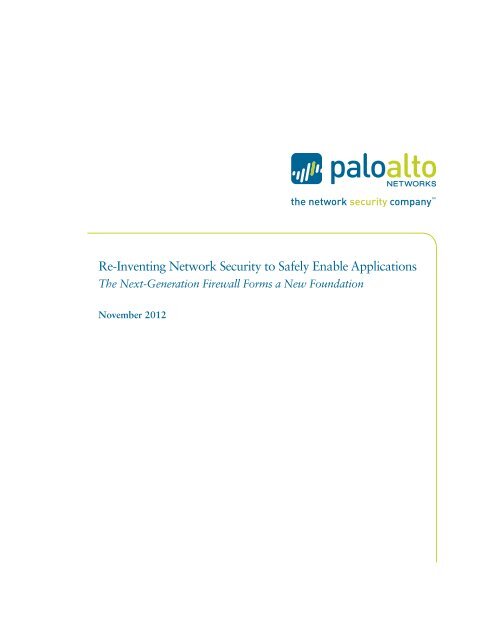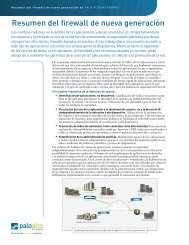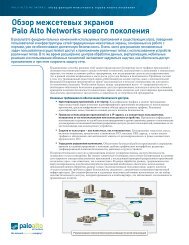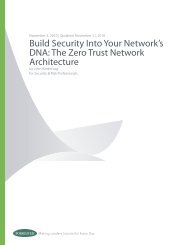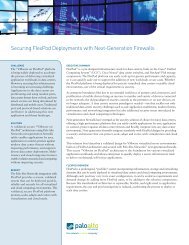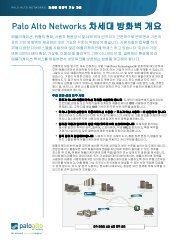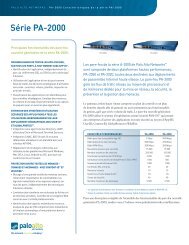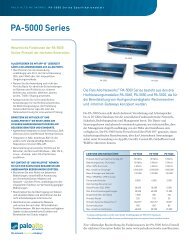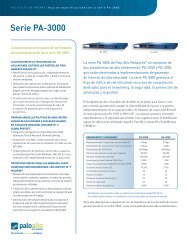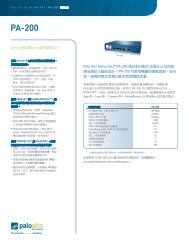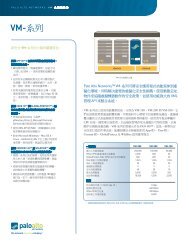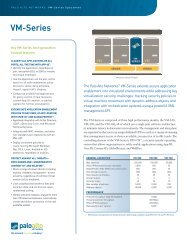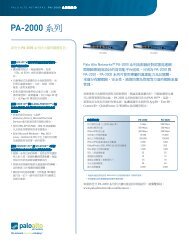Re-Inventing Network Security - Palo Alto Networks
Re-Inventing Network Security - Palo Alto Networks
Re-Inventing Network Security - Palo Alto Networks
Create successful ePaper yourself
Turn your PDF publications into a flip-book with our unique Google optimized e-Paper software.
<strong>Re</strong>-<strong>Inventing</strong> <strong>Network</strong> <strong>Security</strong> to Safely Enable Applications<br />
The Next-Generation Firewall Forms a New Foundation<br />
November 2012
<strong>Palo</strong> <strong>Alto</strong> <strong>Network</strong>s: <strong>Re</strong>-<strong>Inventing</strong> <strong>Network</strong> <strong>Security</strong> to Safely Enable Applications<br />
Executive Summary<br />
It’s no secret that modern applications and threats easily circumvent port-blocking firewalls,<br />
rendering ineffective what has long been the cornerstone of network security. Neither is it surprising<br />
that attempts to remedy this situation by deploying firewall “helpers,” bolting application awareness<br />
onto existing firewall products, or turning to Unified Threat Management devices have all failed.<br />
The bottom line is that approaches which continue to classify traffic based only on ports and protocols<br />
are incapable of enabling the emerging generation of applications, users, and infrastructures.<br />
To address this situation, <strong>Palo</strong> <strong>Alto</strong> <strong>Network</strong>s is re-inventing network security from the ground<br />
up. By focusing on applications, users and content—not ports and protocols—we’re delivering<br />
a truly innovative platform that provides enterprises with the visibility and control required to<br />
safely enable modern applications, without having to absorb the risks that typically accompany<br />
them. At the core of this platform, the <strong>Palo</strong> <strong>Alto</strong> <strong>Network</strong>s Next-Generation Firewall also helps<br />
enterprises simplify their network security infrastructure.<br />
Built on a high-performance architecture and incorporating a rich set of security, networking, and<br />
management functionality, our next-generation firewall significantly reduces network complexity<br />
and cost of ownership by eliminating the need to deploy a wide variety of supplemental network<br />
security products. A set of innovative technologies and enterprise-class capabilities further solidify<br />
enterprise gains by ensuring not only that consistent security and application enablement is available<br />
for all enterprise users and network locations, but also that the solution remains effective despite<br />
the onslaught of advanced malware and targeted attacks.<br />
PAGE 2
<strong>Palo</strong> <strong>Alto</strong> <strong>Network</strong>s: <strong>Re</strong>-<strong>Inventing</strong> <strong>Network</strong> <strong>Security</strong> to Safely Enable Applications<br />
<strong>Network</strong> <strong>Security</strong> is No Longer Black and White<br />
The old model for network security was simple because everything was black and white. Business<br />
applications constituted good, low-risk traffic that should be allowed, while everything else—<br />
including threats—constituted bad traffic that should be stopped. But that’s no longer the case,<br />
primarily for three reasons.<br />
Today’s applications are mostly gray—not black and white. These days, personal productivity and<br />
lifestyle applications that enable people to handle their non-work affairs and maintain online<br />
personas run alongside corporate productivity applications used to automate key business<br />
processes. The problem is not so much the growing diversity of applications, but the inability to<br />
accurately classify any given application as good or bad – particularly when which end of the<br />
spectrum many of them fall on can vary from one user/session to the next.<br />
For example, a personal productivity application used to share product documentation with a<br />
prospective customer would be “good” (medium risk, high reward), while using the same<br />
application to forward details of an upcoming release to a “friends list” that includes employees<br />
of a competitor would be “bad” (high risk, low reward).<br />
A modern network security solution must be able not only to distinguish one type of application<br />
from the next, but also to account for other contextual variables that are applicable in any given<br />
scenario – such as who is using the application, from what type of device, and for what purpose.<br />
Today’s applications are evasive. Several other factors further complicate the core task of<br />
“distinguishing one type of application from the next.” One challenge in particular is that in<br />
order to maximize their usability, many personal productivity and lifestyle applications have<br />
been designed to circumvent traditional firewalls by dynamically adjusting how they communicate.<br />
Common tactics include:<br />
PAGE 3<br />
• Port hopping, where ports/protocols are randomly shifted over the course of a session;<br />
• Use of non-standard ports, such as running Yahoo! Messenger over TCP port 80 instead<br />
of TCP port 5050;<br />
• Tunneling within commonly used services, such as when P2P file sharing or an IM client<br />
like Meebo runs over HTTP; and,<br />
• Hiding within SSL encryption.<br />
Another vexing issue is that many business applications are now being designed to take advantage<br />
of these same techniques. Examples include Box, Microsoft SharePoint and Salesforce.com. This<br />
is typically done to facilitate operation in the broadest set of scenarios and with the least amount of<br />
disruption for customers, partners, and the organization’s own security and operations departments,<br />
but the unintended side effect for IT is further loss of control over network communications.<br />
Even something as seemingly benign as the ongoing “webification” of enterprise applications is<br />
problematic, as legacy network security products are unable to resolve individual applications<br />
from the HTTP and HTTPS sessions that constitute over two thirds of all enterprise traffic.
<strong>Palo</strong> <strong>Alto</strong> <strong>Network</strong>s: <strong>Re</strong>-<strong>Inventing</strong> <strong>Network</strong> <strong>Security</strong> to Safely Enable Applications<br />
Today’s threats are coming along for the ride. The shift in motivation for today’s hackers—from<br />
building reputations to actually making money – also brought applications squarely into their<br />
sights. After all, threats designed to operate at the application layer have multiple opportunities<br />
to circumvent an organization’s defenses. Such threats not only pass right through legacy security<br />
infrastructure built only to provide network-layer protection, but can also obtain “free passage” into<br />
enterprise networks by targeting applications that utilize the aforementioned evasion techniques.<br />
In fact, even products that have been designed to accurately distinguish individual applications will<br />
be susceptible if they don’t also incorporate threat prevention capabilities that enable them to reliably<br />
identify and stop threats riding along with applications the organization designates as “allowed.”<br />
IT is No Longer in Control<br />
To be clear, the problem is not that there have been substantial changes to the application and<br />
threat landscapes; rather, it’s that commonly deployed network security technologies have failed<br />
to keep pace.<br />
<strong>Re</strong>lying on Legacy Port-Blocking Firewalls is Like Flying Blind<br />
Because they are deployed in-line at critical network junctions, firewalls see all traffic. This makes<br />
them the ideal resource to provide granular access control. It turns out, however, that most firewalls<br />
are far-sighted. They can see general shapes, but not the finer details of what’s actually happening.<br />
This is because they operate by inferring the application-layer service that a given stream of traffic<br />
is associated with based on port numbers. They rely on a convention —not a requirement—that<br />
a given port corresponds to a given service (e.g., TCP port 80 corresponds to HTTP). This means<br />
they’re also incapable of distinguishing between different applications that use the same port/service.<br />
PAGE 4<br />
Figure 1: Port Blocking Firewalls Can’t See or Control Applications
<strong>Palo</strong> <strong>Alto</strong> <strong>Network</strong>s: <strong>Re</strong>-<strong>Inventing</strong> <strong>Network</strong> <strong>Security</strong> to Safely Enable Applications<br />
From a technological perspective, the impact of changes to the application landscape is that traditional,<br />
port-blocking firewalls have essentially gone blind. Not only are they unable to account for common<br />
evasion techniques, but they also lack the visibility, contextual awareness, and intelligence to discern:<br />
• which network traffic corresponds to applications that serve a legitimate business purpose;<br />
• which network traffic corresponds to applications that can serve a legitimate business purpose<br />
but, in a given instance, are being used for unsanctioned activities; and,<br />
• which network traffic, even though it corresponds to legitimate business activities, should be<br />
blocked because it includes malware or other types of threats.<br />
Moreover, their response options are too coarse-grained. They can either block or allow traffic, but<br />
offer little variation in between to adequately account for all of the “gray” applications enterprises<br />
ultimately need to support—for example, by allowing certain functions within an application but<br />
not others, applying traffic-shaping policies to certain traffic, or controlling access based on users,<br />
groups, or time of day.<br />
From an operational perspective, the net result is that within many organizations IT has lost control.<br />
The inability of their security infrastructure to effectively distinguish good/desirable applications<br />
from those that are bad/unwanted has left them with an all or nothing decision. They can take a<br />
permissive stance that ensures the accessibility of important applications but also allows unwanted<br />
ones to proceed as well. Or they can just say “no”—an approach that maintains a high state of<br />
security but precludes the use of beneficial gray-area applications while increasing the risk of<br />
accidentally blocking essential business applications.<br />
Firewall <strong>Re</strong>medies Have Failed<br />
Unfortunately, none of the steps previously taken to address the inadequacies of traditional<br />
firewalls have given today’s IT departments what they really need: the confidence to say “yes” to<br />
requests made by the business based on having the ability to exert granular control and provide<br />
in-depth protection down to the level of individual applications.<br />
Bolting-on Deep Packet Inspection is Fundamentally Flawed<br />
Attempting to correct the myopic nature of a traditional firewall by incorporating deep packet<br />
inspection (DPI) capabilities might appear to be a reasonable approach. However, this tactic only<br />
leads to an incremental boost in security effectiveness. The issue is that the new functionality is<br />
integrated rather than embedded, and the port-blocking firewall, with its complete lack of<br />
application awareness, is still used for initial classification of all traffic. As a result:<br />
• Not everything that should be inspected necessarily gets inspected. Because the firewall is<br />
unable to accurately classify application traffic, deciding which sessions get passed to the<br />
DPI engine becomes a hit-or-miss proposition.<br />
• Policy management gets convoluted. Rules on how to handle individual applications get<br />
“nested” within the DPI portion of the product—which itself is engaged as part of a higher/outer<br />
level access control policy.<br />
• Inadequate performance forces compromises to be made. Inefficient use of system resources<br />
and CPU and memory intensive application-layer functionality put considerable strain on the<br />
underlying platform. To account for this situation, administrators can only implement advanced<br />
filtering capabilities selectively.<br />
PAGE 5
<strong>Palo</strong> <strong>Alto</strong> <strong>Network</strong>s: <strong>Re</strong>-<strong>Inventing</strong> <strong>Network</strong> <strong>Security</strong> to Safely Enable Applications<br />
Deploying Firewall “Helpers” Only Creates Another Problem<br />
Suggesting that enterprises compensate for their firewall’s deficiencies by deploying a collection of<br />
additional, standalone security products—such as intrusion prevention, network AV, URL filtering,<br />
and data loss prevention appliances—has an eerily similar outcome, with one added twist.<br />
To begin with, not everything that should get inspected does because the firewall helpers aren’t<br />
exposed to all of the traffic, rely on the same port/protocol-based classification techniques that<br />
have failed the legacy firewall, or only provide coverage for a limited set of applications. Policy<br />
management is an even greater problem due to access control and inspection rules being spread<br />
across several consoles and involving multiple policy models. And performance is still an issue<br />
too, at least in terms of having a relatively high aggregate latency.<br />
Then comes the twist: device sprawl. As one “solution” after another is added to the network,<br />
device count, complexity, and total cost of ownership all continue to rise. The result is an<br />
unwieldy, ineffective, and costly endeavor that is simply not sustainable.<br />
UTM Only Makes What is Broken Cheaper<br />
Another proposed remedy, the Unified Threat Management (UTM) device at least helps alleviate<br />
device sprawl. Instead of having a bunch of “helper” countermeasures deployed as separate devices,<br />
with UTM they all come in one physical package. But so what? The result is really no different<br />
than the bolted-on approach and, therefore, exhibits the same deficiencies. Inadequate application<br />
classification and blind spots in the inspections that are performed remain as fundamental problems,<br />
while performance and policy management issues are compounded based on having to account<br />
for multiple additional countermeasures instead of just one (i.e., DPI).<br />
It’s Time to <strong>Re</strong>-invent <strong>Network</strong> <strong>Security</strong><br />
The bottom line is that network security in most enterprises is fragmented and broken, exposing<br />
the business to unwanted risks and ever-rising costs. Traditional network security solutions have<br />
simply failed to keep pace with changing conditions, and the remedies put forth to compensate<br />
for their deficiencies have proven ineffective.<br />
What today’s enterprises need instead is a solution that:<br />
• Enables IT to confidently say “yes” to whatever applications are needed to best support the<br />
business – by delivering the ability to accurately identify and granularly control applications<br />
while also preventing a broad array of threats;<br />
• Achieves comprehensive coverage – by providing a consistent set of protection and enablement<br />
capabilities for all users and networks, regardless of their location; and,<br />
• Simplifies security and networking infrastructure and operations – by obviating the need for<br />
numerous standalone products, each with its own policy construct, logs, and management console.<br />
PAGE 6
<strong>Palo</strong> <strong>Alto</strong> <strong>Network</strong>s: <strong>Re</strong>-<strong>Inventing</strong> <strong>Network</strong> <strong>Security</strong> to Safely Enable Applications<br />
Introducing the Next-Generation Firewall<br />
From the outset, <strong>Palo</strong> <strong>Alto</strong> <strong>Network</strong>s mission has been to restore the firewall as the<br />
cornerstone of enterprise network security infrastructure by “fixing the problem at its core.”<br />
Starting with a blank slate, a world-class engineering team took an application-centric<br />
approach to traffic classification in order to enable full visibility and control of all types of<br />
applications running on enterprise networks – new-age and legacy ones alike. The result is<br />
the <strong>Palo</strong> <strong>Alto</strong> <strong>Network</strong>s next-generation firewall – the only solution that fully delivers on<br />
the essential functional requirements for a truly effective, modern firewall:<br />
• Identify applications regardless of port, protocol, evasive tactics or SSL encryption<br />
• Enable fine-grained visibility and policy control over application access and functionality<br />
• Identify and control users regardless of IP address, location, or device<br />
• Protect against known and unknown application-borne threats<br />
• Support multi-gigabit, in-line deployments with negligible performance degradation<br />
The key to this distinction is the combination of several innovative technologies, a highperformance<br />
architecture, and a robust set of additional enterprise-class capabilities that<br />
deliver a complete, end-to-end network security solution.<br />
Unique Identification and Detection Technologies <strong>Re</strong>store<br />
Visibility and Control<br />
A collection of unique identification and content detection technologies enable enterprises<br />
to focus on business relevant elements such as applications, users, and content for policy<br />
controls, instead of having to rely on nebulous and often misleading attributes such as<br />
ports and protocols. Also significant is the resulting unified management model, which<br />
dramatically simplifies security operations by providing administrators with one place to<br />
manage rules that seamlessly account for all relevant attributes and mitigations and one<br />
place to obtain and analyze all corresponding log information.<br />
PAGE 7<br />
APPLICATIONS, USERS AND CONTENT – ALL UNDER YOUR CONTROL<br />
SQLIA<br />
Figure 2: Next-Generation Firewalls Focus on Applications, Users, and Content<br />
SQLIA<br />
Authorized Finance User<br />
Authorized Sales User<br />
Authorized User<br />
Authorized User
<strong>Palo</strong> <strong>Alto</strong> <strong>Network</strong>s: <strong>Re</strong>-<strong>Inventing</strong> <strong>Network</strong> <strong>Security</strong> to Safely Enable Applications<br />
Positively Identify Applications<br />
App-ID is the patent-pending traffic classification technology at the heart of the nextgeneration<br />
firewall. With App-ID, up to four distinct mechanisms are used to determine the exact<br />
identity of more than 1500 applications traversing the network—irrespective of port, protocol,<br />
evasive tactic or encryption.<br />
Application Signatures. Used at multiple steps in the classification process, context-based signatures<br />
look for unique properties and transaction characteristics that identify applications regardless<br />
of the port or protocol being used.<br />
SSL/SSH Decryption. If SSL or SSH encryption is in use and a decryption policy is in place, the<br />
traffic is decrypted and passed on to other mechanisms as needed.<br />
Application Protocol Decoding. Decoders for known protocols validate conformance to the<br />
protocol specification, detect other applications tunneling inside of the protocol, and identify<br />
individual functions within a given application (e.g., WebEx Desktop Sharing).<br />
Heuristics. Additional heuristic/behavioral techniques are engaged as needed to identify troublesome<br />
applications that typically elude advanced signature and protocol analysis, such as peer-topeer<br />
or VoIP tools that use proprietary encryption.<br />
Policy checks at multiple steps help guide the process and provide opportunities for granular<br />
control. In addition, a powerful application browser (ACC) delivers a wealth of intelligence<br />
about detected applications so that administrators can make well-informed decisions. With ACC,<br />
applications can be viewed by category, subcategory, underlying technology and characteristics<br />
such as: file transfer capabilities, the ability to evade detection, and the propensity to consume<br />
bandwidth, transmit malware, or otherwise be misused. For any “unknown” application traffic<br />
that is detected, administrators have the option of submitting a sample to <strong>Palo</strong> <strong>Alto</strong> <strong>Network</strong>s for<br />
development of a new App-ID, or generating their own custom App-ID.<br />
With App-ID, IT obtains not only a clearer picture of what’s happening on their networks, but also<br />
the ability to create and enforce policies that deliver secure application enablement.<br />
PAGE 8<br />
Start<br />
Check<br />
IP/Port<br />
Policy Check<br />
Check Application<br />
Signatures<br />
Decryption<br />
(SSL or SSH)<br />
Policy Check<br />
KNOWN PROTOCOL DECODER<br />
Decode<br />
REPORT & ENFORCE POLICY<br />
Check<br />
Signatures<br />
IDENTIFIED TRAFFIC (NO DECODING)<br />
UNKNOWN PROTOCOL DECODER<br />
Apply Heuristics<br />
Policy<br />
Check<br />
Figure 3: App-ID Identifies Applications Across All Ports<br />
Policy<br />
Check
<strong>Palo</strong> <strong>Alto</strong> <strong>Network</strong>s: <strong>Re</strong>-<strong>Inventing</strong> <strong>Network</strong> <strong>Security</strong> to Safely Enable Applications<br />
Figure 4: User-ID Integrates Enterprise Directories for User-based Policies, <strong>Re</strong>porting and Forensics<br />
Securely Enabling Applications Based on Users and Groups<br />
User-ID seamlessly integrates <strong>Palo</strong> <strong>Alto</strong> <strong>Network</strong>s firewalls with a range of enterprise directory<br />
and terminal services products, enabling administrators to tie application activity and security<br />
policies to users and groups—not just IP addresses. Working together, network-based User-ID<br />
Agents and next-generation firewalls use a combination of techniques—including login monitoring,<br />
end-station polling, standard LDAP queries, captive portal, and XML API-based interrogation—<br />
to maintain user-to-IP address relationships and harvest relevant details (e.g., group assignments).<br />
These details are then available to:<br />
• Identify the specific users responsible for all application, content, and threat traffic on the network;<br />
• Extend user-based application enablement policies across Microsoft Windows, MAC OS X,<br />
Apple iOS, Unix, and terminal services users; and,<br />
• Facilitate user-based analysis, reporting and forensics.<br />
With User-ID, IT departments get another powerful mechanism to enable intelligent control of<br />
applications. For example, a social networking application that would normally be blocked because<br />
of its risky nature can now be enabled for individuals or groups that have a legitimate need to use<br />
it, such as the human resources department.<br />
High-performance Content Control and Threat Prevention<br />
Like their counterpart technologies, Content-ID and WildFire infuse the <strong>Palo</strong> <strong>Alto</strong> <strong>Network</strong>s<br />
next-generation firewall with capabilities previously unheard of in an enterprise firewall. The net<br />
result is the ability to further control access through the firewall based on the nature of the content<br />
being communicated, and whether or not it contains any threats.<br />
PAGE 9<br />
eDirectory<br />
Domain<br />
Controller<br />
Client<br />
Probing<br />
Joe<br />
••••••••<br />
Captive<br />
Portal<br />
GlobalProtect<br />
USER AUTHENTICATION<br />
Joe’s Devices<br />
11.11.11.11<br />
12.12.12.12<br />
Joe’s Roles/Groups<br />
IT Admins<br />
HQ Employees<br />
Terminal<br />
Services<br />
Agent<br />
Wireless<br />
Proxy<br />
AUTHENTICATION EVENT XML API<br />
REPORT & ENFORCE POLICY<br />
Directories<br />
Active Directory<br />
LDAP<br />
NAC
<strong>Palo</strong> <strong>Alto</strong> <strong>Network</strong>s: <strong>Re</strong>-<strong>Inventing</strong> <strong>Network</strong> <strong>Security</strong> to Safely Enable Applications<br />
Intrusion Prevention and <strong>Network</strong> Antivirus. An embedded, NSS Labs <strong>Re</strong>commended intrusion<br />
prevention system protects networks from all types of vulnerability exploits, buffer overflows, DoS<br />
attacks and port scans. Traffic normalization eliminates invalid packets, while TCP reassembly and IP<br />
de-fragmentation counteract packet-level evasion techniques to ensure the utmost accuracy and<br />
protection. In addition, known viruses and malware are eliminated from allowed traffic using our<br />
own database of millions of malware samples and a stream-based scanning technique that minimizes<br />
latency by not waiting for entire files to be loaded into memory before starting the scanning process.<br />
Performance is further enhanced by leveraging a uniform threat signature format that makes it<br />
possible to detect both intrusions and viruses with a single pass of a single scanning engine.<br />
Modern Malware Defense. Complementing the Content-ID threat prevention capabilities, WildFire<br />
delivers essential protection against the rising tide of custom, targeted, and otherwise unknown<br />
malware bombarding today’s enterprises. Subject to administrator-configured policies, unknown<br />
files and correlating information detected by the firewall are submitted to the WildFire virtualized<br />
sandbox. A cloud-based component that eliminates the need for additional dedicated hardware at<br />
every ingress point to an enterprise’s network, the sandbox provides virtual targets where potentially<br />
dangerous files can be executed and observed for malicious behavior. For samples identified as malware,<br />
new protection signatures are automatically generated, tested for accuracy, and then distributed<br />
to all <strong>Palo</strong> <strong>Alto</strong> <strong>Network</strong>s customers as part of the daily malware signature updates. Customers<br />
with a WildFire subscription receive priority delivery in less than one hour. They also gain access<br />
to a wealth of actionable intelligence about newly detected malware through the WildFire portal.<br />
Detailed reports document observed behaviors and provide useful information about targeted users,<br />
applications, URLs, and so forth.<br />
All of the threat prevention capabilities discussed fully leverage App-ID, thereby ensuring that threats<br />
and unknown files are detected even when evasive techniques are employed.<br />
URL Filtering. A fully integrated, on-box URL database with 20 million entries across 76 categories<br />
allows administrators to control web surfing and access to high risk sites. Support for custom entries<br />
and categories and the ability to pull additional entries into cache from a hosted, 180 million URL<br />
database help ensure nothing slips through the cracks.<br />
File and Data Filtering. Administrators can implement policies that reduce the risks from unwanted<br />
exposure of confidential information by taking advantage of embedded capabilities to: block files<br />
by their actual type (i.e., not based on just their extension), filter traffic for sensitive data patterns<br />
such as credit card and social security numbers, and control the file transfer functionality within<br />
individual applications, such as instant messaging clients.<br />
The bottom line is that with Content-ID and WildFire, IT departments get additional, powerful<br />
mechanisms for controlling network access along with fully integrated, broad-spectrum threat<br />
prevention – all without having to invest in a collection of standalone products and their separate<br />
policies, operations, and views of the world.<br />
Applications<br />
• All traffic, all ports, all the time<br />
• Application signatures<br />
• Heuristics<br />
• Decryption<br />
• <strong>Re</strong>duce the attack surface<br />
• <strong>Re</strong>move the ability to hide<br />
PAGE 10<br />
Exploits & Malware<br />
• Block threats on all ports<br />
• NSS Labs <strong>Re</strong>commended IPS<br />
• Millions of malware samples<br />
• Prevents known threats<br />
• Exploits, malware,<br />
C&C traffic<br />
Dangerous URLs<br />
• Malware hosting URLs<br />
• Newly registered domains<br />
• SSL decryption of high-risk sites<br />
• Block known sources of threats<br />
• Be wary of unclassified and<br />
new domains<br />
Unknown & Targeted Threats<br />
• WildFire detection of unknown<br />
and targeted malware<br />
• Unknown traffic analysis<br />
• Anomalous network behaviors<br />
• Pinpoints live infections and<br />
targeted attacks<br />
> > > > > > > > > > > > > > > > > > > > > > > > > > > Decreasing Risk > > > > > > > > > > > > > > > > > > > > > > > > > > ><br />
Figure 5: Next-Generation Firewall Delivers Fully Integrated, Broad-Spectrum Threat Prevention
<strong>Palo</strong> <strong>Alto</strong> <strong>Network</strong>s: <strong>Re</strong>-<strong>Inventing</strong> <strong>Network</strong> <strong>Security</strong> to Safely Enable Applications<br />
High-Performance Architecture Delivers “<strong>Security</strong> Without Compromises”<br />
Having a comprehensive suite of application awareness and content inspection capabilities makes<br />
little difference if administrators are unable to fully engage them due to performance constraints.<br />
Accordingly, <strong>Palo</strong> <strong>Alto</strong> <strong>Network</strong>s designed the next-generation firewall to have a single pass,<br />
parallel processing (SP3) architecture.<br />
Figure 6: Single Pass Parallel Processing Architecture Optimally Combines Software and<br />
Hardware for Superior Performance<br />
With most conventional network security products, each high-level function processes the traffic<br />
stream independently. The resulting multi-pass approach requires low-level packet handling and<br />
stream reassembly routines to be repeated numerous times. System resources are used inefficiently<br />
and considerable latency is introduced. In contrast, the processing model for the <strong>Palo</strong> <strong>Alto</strong> <strong>Network</strong>s<br />
next-generation firewall is highly structured and essentially linear. This eliminates repetitive handling<br />
of packets and streams, dramatically reducing the burden placed on system hardware and<br />
minimizing latency.<br />
Performance is further enhanced by having separate control and data planes, with the latter<br />
having function-specific, parallel processing hardware engines, including:<br />
• a network processor for initial packet handling and other network-layer functions;<br />
• a multi-core security processor and hardware-based acceleration for standardized<br />
functions; and,<br />
• a dedicated content scanning engine.<br />
Delivering up to 20 Gbps of low-latency, App-ID throughput, the net result is a solution that<br />
delivers next-generation visibility and control of applications, users, and content without having<br />
to make any compromises.<br />
PAGE 11
<strong>Palo</strong> <strong>Alto</strong> <strong>Network</strong>s: <strong>Re</strong>-<strong>Inventing</strong> <strong>Network</strong> <strong>Security</strong> to Safely Enable Applications<br />
Fixing the Firewall is Only the First Step<br />
Although it is an essential starting point, fixing the firewall is only the first step toward delivering<br />
truly effective network security. After all, it’s not just the application landscape that has changed in<br />
recent years. Today’s IT managers are also struggling to account for:<br />
• an increasingly mobile workforce;<br />
• the growing adoption of public cloud services; and<br />
• the transition to highly virtualized, cloud-like data centers.<br />
All of these trends are having an impact not only on what capabilities are needed to safely enable<br />
applications, but, to an even greater extent, on where those capabilities are needed. Simply put, it’s<br />
no longer enough to implement firewalls solely at the network perimeter. Accordingly, another<br />
mission for <strong>Palo</strong> <strong>Alto</strong> <strong>Network</strong>s has been to ensure that our next-generation firewall is applicable<br />
for all users and network locations requiring robust network security and safe application enablement.<br />
Enterprise-class Capabilities Ensure Consistent <strong>Security</strong> Everywhere<br />
The days of relying primarily on perimeter-based defenses for network security are all but gone.<br />
A host of factors—including geographically distributed offices, mobile users, and even local users<br />
with mobile devices—now dictate the need for a far greater number of security enforcement points.<br />
The goal of <strong>Palo</strong> <strong>Alto</strong> <strong>Network</strong>s in this regard is to deliver a solution that accounts for the unique<br />
requirements of all users and locations yet still provides a consistent set of protection and application<br />
enablement capabilities—all without having to manage a completely independent set of policies<br />
and infrastructure.<br />
Specific ways <strong>Palo</strong> <strong>Alto</strong> <strong>Network</strong>s provides coverage for more than just the network perimeter<br />
include the following:<br />
<strong>Palo</strong> <strong>Alto</strong> <strong>Network</strong>s for the Data Center. Suitability for deployment in enterprise data centers begins<br />
with the SP3 Architecture and a core design that delivers robust network security without having to<br />
make compromises due to performance considerations. Equally important is the ability to stop modern<br />
threats and rogue applications from operating in an organization’s “inner sanctum.” Support for a broad<br />
range of networking technologies (e.g., L2/L3 switching, dynamic routing, 802.1Q VLANs, trunked<br />
ports, traffic shaping, etc.), deployment modes, and high availability configurations also ensures the<br />
ability to “fit in” to whatever data center design/architecture an enterprise might have. Additional data<br />
center-friendly capabilities include the following:<br />
• Support for segmentation and multi-tenant configurations. A virtual systems capability allows<br />
administrators to configure multiple, independent firewall instances within a single physical<br />
firewall appliance. Each instance has its own set of policies and management interface, providing<br />
a convenient and economical approach for IT to segment applications, servers, and data resources<br />
(e.g., for compliance purposes), or provide separate support for different business units and<br />
internal constituencies.<br />
PAGE 12
<strong>Palo</strong> <strong>Alto</strong> <strong>Network</strong>s: <strong>Re</strong>-<strong>Inventing</strong> <strong>Network</strong> <strong>Security</strong> to Safely Enable Applications<br />
• Support for enterprise cloud networks. With the introduction of the <strong>Palo</strong> <strong>Alto</strong> <strong>Network</strong>s VM-<br />
Series, enterprises now have the option of deploying virtual machine-based instances of our<br />
next-generation firewall that feature the same application, user, and content control capabilities<br />
as with our physical appliances. A unified policy and management model that spans both<br />
VM-based and physical firewall appliances and a dynamic address object feature—which<br />
pins policies to migrating VMs/workloads—helps ensure consistent security while simplifying<br />
administration. In addition, an XML API delivers out-of-the-box integration with third-party<br />
orchestration and automation tools to enable dynamic firewall provisioning and management.<br />
The net result is a highly affordable and easy-to-implement option that enables IT managers<br />
to: (a) extend next-generation firewall coverage to locations and use cases where cost was<br />
previously an issue, (b) provide robust security for network-in-a-box configurations, (c) ensure<br />
policies and protections are maintained for migratory workloads, and (d) fully support the<br />
transformation to dynamic, cloud-like data centers.<br />
<strong>Palo</strong> <strong>Alto</strong> <strong>Network</strong>s for Branch Offices. Enterprises can establish a consistent level of protection<br />
and secure application enablement across all of their offices and facilities, regardless of size, by<br />
taking advantage of a portfolio of a dozen firewall appliances that blanket the performance/<br />
throughput spectrum, from under 100 Mbps to 20 Gbps, and offer a wide variety of interface<br />
choices. This includes the newest addition to the family, the PA-3000 series, which provides even<br />
more price/performance options for intermediate-size sites. In addition to supporting directto-Internet<br />
activities for distributed users, new PAN-OS capabilities also enable simple, rapid<br />
configuration of large-scale site-to-site VPNs for secure inter-office communication.<br />
<strong>Palo</strong> <strong>Alto</strong> <strong>Network</strong>s for Mobile Users. A persistent client component that can be installed on-<br />
demand, GlobalProtect solves the security challenges introduced by roaming users by extending<br />
the same next-generation firewall policies and protection enforced within the physical perimeter<br />
to all users, no matter where they are located. When a remote user logs into their device, Global-<br />
Protect automatically determines the closest next-generation firewall, transparently authenticates<br />
the user, and establishes a secure connection (using SSL or IPSec). Users can then access corporate<br />
network and Internet-based resources subject to the same policies and protection that apply<br />
when operating locally. A consistent user experience and level of security is provided without the<br />
need to create and manage multiple, separate sets of policies. The only difference is that policies<br />
can expanded to also account for the security status of the user’s device, such as whether the latest<br />
patches are installed.<br />
Tying everything together is Panorama, a centralized management system that can optionally be<br />
deployed on available server hardware or <strong>Palo</strong> <strong>Alto</strong> <strong>Network</strong>s M-100 management appliances.<br />
Sharing the same look and feel as the device-level command line and web interface management<br />
options, Panorama simplifies network security management by providing a single, unified console<br />
for conducting all policy management, software and content update, logging, and reporting tasks<br />
across all components of the <strong>Palo</strong> <strong>Alto</strong> <strong>Network</strong>s solution.
<strong>Palo</strong> <strong>Alto</strong> <strong>Network</strong>s: <strong>Re</strong>-<strong>Inventing</strong> <strong>Network</strong> <strong>Security</strong> to Safely Enable Applications<br />
A New Foundation for Securing <strong>Network</strong>s and Safely Enabling Applications<br />
The <strong>Palo</strong> <strong>Alto</strong> <strong>Network</strong>s next-generation firewall provides today’s enterprises with precisely what<br />
they need to take back control of their networks, to stop making compromises when it comes to<br />
information security, to put an end to costly appliance sprawl, and to get back to the business of<br />
making money. By delivering the visibility, control, and fully integrated threat protection required<br />
to safely enable applications for all users and network locations, <strong>Palo</strong> <strong>Alto</strong> <strong>Network</strong>s’ innovative<br />
platform substantially raises the bar for security and operational efficiency while establishing a<br />
new foundation for enterprise network security.<br />
3300 Olcott Street<br />
Santa Clara, CA 95054<br />
Main: +1.408.573.4000<br />
Sales: +1.866.320.4788<br />
Support: +1.866.898.9087<br />
www.paloaltonetworks.com<br />
Copyright ©2013, <strong>Palo</strong> <strong>Alto</strong> <strong>Network</strong>s, Inc. All rights reserved. <strong>Palo</strong> <strong>Alto</strong> <strong>Network</strong>s,<br />
the <strong>Palo</strong> <strong>Alto</strong> <strong>Network</strong>s Logo, PAN-OS, App-ID and Panorama are trademarks of<br />
<strong>Palo</strong> <strong>Alto</strong> <strong>Network</strong>s, Inc. All specifications are subject to change without notice.<br />
<strong>Palo</strong> <strong>Alto</strong> <strong>Network</strong>s assumes no responsibility for any inaccuracies in this document<br />
or for any obligation to update information in this document. <strong>Palo</strong> <strong>Alto</strong> <strong>Network</strong>s<br />
reserves the right to change, modify, transfer, or otherwise revise this publication<br />
without notice. PAN_WP_<strong>Re</strong><strong>Inventing</strong>_121212


